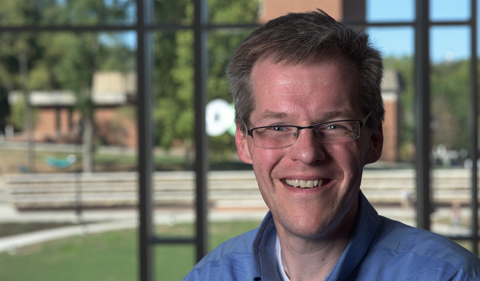
Dr. Daniel Phillips
For the past two years, Dr. Daniel Phillips, Professor of Physics & Astronomy, has been at the helm of Ohio University’s Institute of Nuclear & Particle Physics. During this time, INPP faculty members received external awards totaling more than $3.7 million to conduct studies in theoretical and experimental nuclear physics over a huge range of distances.
“INPP research includes investigations of the internal structure of the proton at distances smaller than one-millionth of the size of an atom,” Phillips explains. “But it also includes developing better theories of neutron stars: collections of neutrons and protons that are several miles across. And INPP researchers did a lot of other exciting research on systems with sizes between those limits.”
Phillips says the institute is a perfect vehicle to proactively educate students in these fields of study, sponsor joint seminars, host visiting scientists, and provide matching funds for new initiatives undertaken with federal agencies and national laboratories.
Phillips brings experience and passion for nuclear physics to his director position. He was named a Fellow of the American Physical Society in 2008 and an American Physical Society Outstanding Referee for 2014. He is a member of the Nuclear Science Advisory Committee that provides advice to the NSF and the U.S. Department of Energy on nuclear-physics priorities, and he just finished a two-year term as chair of the National Advisory Committee for the DOE’s Institute of Nuclear Theory. Phillips came to OHIO in 2000, after doing his Ph.D. at Flinders University in Australia and post-doctoral stints at the University of Washington and the University of Maryland.
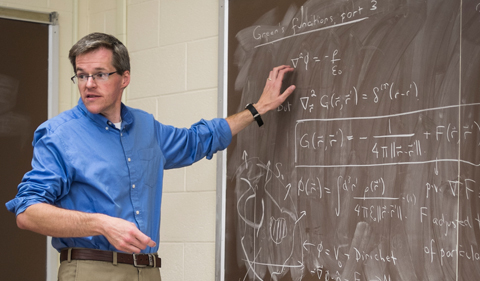
In the classroom Phillips teaches undergraduate and graduate courses ranging from introductory physics to advanced quantum theory.
In his Q&A below, Phillips describes the kind of physics he studies and how INPP has enabled him and his INPP colleagues to collaborate with physicists from around the world.
Q: What kind of physics do you study?
I work on developing theories of atomic nuclei. This includes a range of problems in nuclear physics. The last few years I’ve been trying to understand the physics of nuclei with extended neutron distributions. These “neutron halo” nuclei have a few neutrons that orbit very far from their center; the neutrons actually spend most of their time in a region where they should not exist from the point of view of Newtonian physics! This means that, for example, an isotope of lithium, 11Li, has a radius as large as the lead isotope 208Pb, but with only 5 percent as many particles in the nucleus.
Q: Why is it important to study neutron halos?
There are many neutron halos, and in general nuclei can be quite different. Details tend to matter in nuclear physics. But I want to know what features the neutron halo nuclei have in common. It seems that the fact that the neutrons in these systems live far from the nuclear center gives them certain “universal” properties. It turns out they share some of those properties with other systems in different branches of physics, e.g. clusters of Helium atoms. This is intimately tied to the magic of quantum mechanics, which predicts some strange and wonderful features in such systems.
Q: Why is it important to know about nuclei and nuclear reactions?
For the nuclei I look at, most stable ones have about the same number of neutrons and protons. But we can always make other isotopes by adding neutrons to the nucleus. Except that eventually you saturate your ability to bind neutrons to the nucleus, and any more neutrons you try to add don’t stick to the nucleus. But, if you add just the right number of neutrons, you can produce a neutron halo: an extended neutron distribution that forms because the neutrons are right on the edge of not being bound to the nucleus. Understanding what makes some neutron halos stable, and others not, can, therefore, give a lot of insight into unstable nuclei and what it takes to make new isotopes. Those isotopes can be useful for medical, technological, or other applications.
Q: How have your research interests changed since you received your Ph.D.?
When I did my Ph.D., I was very interested in “fundamental” theories of nature: the Higgs boson, the Standard Model of Particle Physics etc. I’m still interested in those things, but I’ve come to appreciate the complexity and variety of nuclei. The fundamental forces governing nuclei are actually quite simple. You can write the mathematical rules for them on a T-shirt. But those forces generate the full variety of elements we see on Earth. And the fact that those elements exist in the proportions they do is a miracle of nuclear physics, since all of them were produced in nuclear reactions—either in the Big Bang or subsequently in stars.
Q: How has INPP enabled you to collaborate with others?
INPP has provided invaluable support for my research over the years. It’s financial help has made it possible to bring prominent international scholars, whom I then collaborated with on research, for extended stays on campus. Last year INPP sponsored, together with Argonne National Laboratory, the 21st International Conference on Few-body Problems in Physics, which Charlotte Elster and I co-chaired. This is the major conference in my field. I attended the 1992 meeting in this triennial series just as I started my Ph.D., it was my first scientific meeting. In May 2015 about 250 researchers from around the world came to Chicago to discuss problems that—like the halo nuclei that I’m presently interested in—can be described in terms of a few participating particles. There were a great range of plenary, and other, presentations that gave a terrific snapshot of “few-body physics.” Current and former researchers from INPP featured prominently!
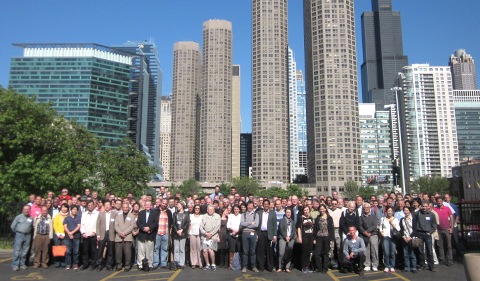
INPP members Charlotte Elster and Daniel Phillips served as co-chairs of the 21st International Conference on Few-Body Problems in Physics held in Chicago, where the latest research advances on few-body systems were discussed. The conference convenes every three years and has been held in locations as diverse as Japan, Germany, Brazil, North Carolina, and Taiwan.
Q: What is something you have learned from an INPP-sponsored activity?
I have learned a tremendous amount from the weekly seminars. I came here after doing post-docs at much larger institutions, and at those places I don’t think I got to see the full breadth of nuclear-physics research, partly because the seminars were all seminars about theoretical models and only a few experimental colleagues participated. INPP has a very broad research effort, and we try to invite visitors to come and make our understanding broader still, as well–of course–as deeper within the areas where we have expertise. I have benefited greatly from hearing discussions between the excellent experimental scientists we have here and visitors who come to present their work. I’ve gained a lot of appreciation for the complexities of experimental research as a result, and that, in turn has informed directions in my own research.
Q: What is it about the INPP collaboration that has helped you to become a better scientist?
I point to our faculty. We have many strong researchers, all of whom are very well respected in the U.S. nuclear-physics community. When the U.S. nuclear-physics community did strategic planning a couple of years ago, every INPP faculty member got asked to participate in some capacity. But, more than that, I am proud of our faculty because we work together very well. I count the INPPers as some of my best friends; they are not only excellent scientists they are collegial, friendly, and helpful. And this, combined with their research expertise, makes Ohio University stronger as they bring all those positives to their work with students in the classroom and in research, and to their collaborations with other faculty.
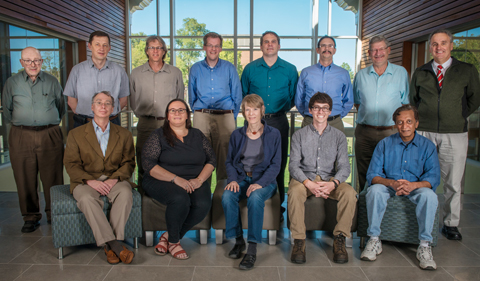
INPP members include: (front row, from left) Kenneth Hicks, Julie Roche, Charlotte Elster, Zach Meisel, Madappa Prakash; (back row, from left) Steven Grimes, Alexander Voinov, Carl Brune, Daniel Phillips, Justin Frantz, Paul King, Tom Massey, and David Ingram
As members of a research organization, INPP faculty work together on topics in both theoretical and experimental subatomic physics. Established in 1991, the institute brings together faculty members, staff, and students who conduct successful, diverse research in nuclear and particle physics.



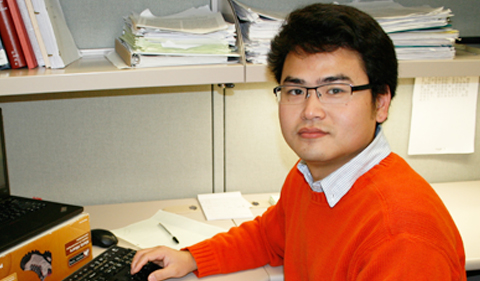















Comments